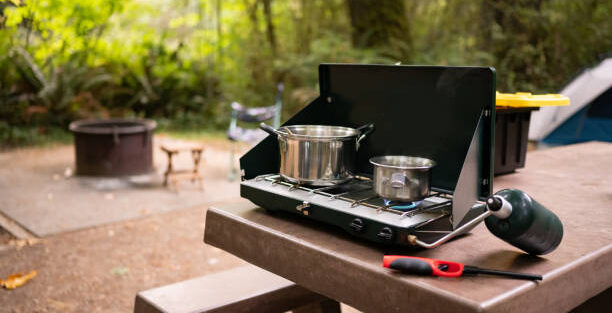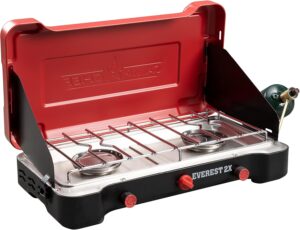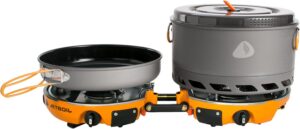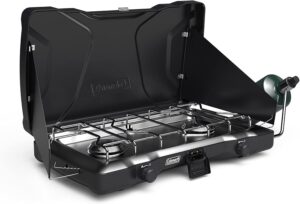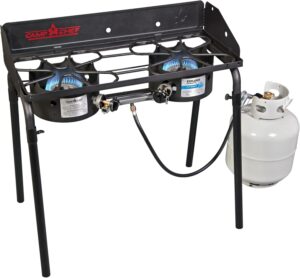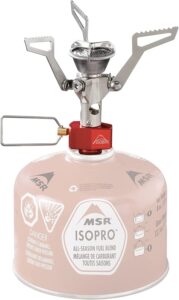Introduction:
Picking the right camping stove can seriously shape your outdoor cooking adventure. Whether you’re backpacking deep into the wild or setting up a cozy base camp with friends, good cooking gear really matters.
We tested and compared the top camping stoves to help you find the right fit for your camping style and budget. From featherweight canister stoves for solo hikers to big, multi-burner setups for families, each stove brings something different to the table.
Our comparison digs into fuel efficiency, ignition systems, weight, and durability. We’ll break down the features that count, explain fuel types, and call out the standouts from top brands so you can pick a stove that fits your camping equipment needs.
Top Camping Stoves Compared
We looked at heat output, fuel efficiency, build quality, and how easy each stove is to use. The list includes both beefy basecamp units and tiny backpacking stoves for different outdoor cooking situations.
Camp Chef Everest 2X
The Camp Chef Everest 2X pumps out 20,000 BTUs per burner, making it our top pick for group camping. Its wind resistant design held up well in tough weather.
Open, it measures 14 x 26 inches and weighs 12 pounds, pretty manageable for car camping, less so for backpacking.
Key Features:
- Matchless ignition system
- Removable legs for tabletop use
- Heat control knobs with solid adjustment
- Works with 16.4 oz propane bottles
We boiled a quart of water in 4 minutes per burner. The cooking surface fits most pots and pans, even bigger ones.
Setup’s quick at just under 2 minutes. The legs fold flat, and everything packs into the carrying case.
Jetboil Genesis Basecamp
The Jetboil Genesis Basecamp delivers 10,000 BTUs per burner and has great simmer control. Its modular design lets you connect multiple units, which is actually handy.
This two-burner system weighs 9 pounds and measures 11 x 22 inches. Pots up to 10 inches wide fit easily.
Performance Highlights:
- Boils 1 liter in 3.5 minutes
- Fuel efficiency: 12,000 BTUs per hour
- Works down to 15°F
- Hooks up to standard propane canisters
The adjustable legs help keep things steady on rough ground. The piezo ignition fired up every time, even after tons of uses.
Wind resistance is excellent. The burner shields flames so you don’t need extra windscreens.
MSR WindBurner
The MSR WindBurner thrives in wind, thanks to its enclosed burner. We saw steady performance in winds over 25 mph, where other stoves just couldn’t keep up.
This single-burner weighs 1 pound 5 ounces. It puts out 7,000 BTUs and boils a liter in 4.5 minutes.
Wind Performance Data:
- No efficiency loss up to 20 mph winds
- Enclosed radiant burner tech
- Works with MSR cookware
- Fuel canister attachment included
The cookware locks onto the burner, never had it disconnect, even once. Fuel efficiency is up there with the best compact stoves.
With one 8 oz canister, we got about 22 boils. That’s pretty solid for backcountry use.
Coleman Triton
The Coleman Triton gives you reliable cooking at a budget friendly price. It’s a solid pick for weekend trips and family getaways.
This two-burner model puts out 11,000 BTUs per side. It weighs 11 pounds and is 22 x 12 inches set up.
Value Features:
- Instant matchless lighting
- Adjustable burner controls
- Removable drip tray
- Uses 16.4 oz propane cylinders
We consistently boiled water in 5 minutes. The grates fit pots from 6 to 12 inches.
The steel build holds up well. After some heavy use, we barely saw any wear.
Setup’s tool-free and takes less than 3 minutes.
Camp Chef Explorer
The Camp Chef Explorer is for serious outdoor cooks, with 30,000 BTUs per burner. It’s the go-to for big groups and longer trips.
This two-burner weighs 27 pounds and measures 16 x 38 inches. The cooking surface can handle restaurant-sized pots.
Heavy-Duty Specifications:
- Cast iron cooking grates
- Matchless ignition on both burners
- Removable legs and side shelves
- Uses bulk propane tanks
We cooked large batches without a hitch. The high heat is great for wok cooking and searing.
Wind resistance is solid, thanks to the enclosed burner. We used it in 15 mph winds and had no issues.
The carrying bag and modular setup help with transport, even though it’s heavy.
MSR PocketRocket 2
The MSR PocketRocket 2 is tiny, just 2.6 ounces but still puts out 8,200 BTUs. For ultralight backpacking, it’s hard to beat.
We boiled a liter of water in 3.5 minutes. When folded, it fits in your palm.
Ultralight Features:
- Folds to 2 x 2 x 3 inches
- Pot supports for cookware up to 6 inches
- Works with isobutane canisters
- Piezo ignition system
We barely noticed the weight on multi-day trips. The pot supports are surprisingly stable for such a small stove.
One 8 oz canister gave us 60+ boils. Performance stayed steady from sea level to 10,000 feet.
It does need a windscreen in breezy conditions, though.
Feature Comparison: What Matters Most in Camping Stoves
Heat output drives how fast you can cook and boil water. Wind resistance keeps the flame going when the weather turns. Simmer control helps you avoid burning delicate foods.
Heat Output and BTU Performance
BTUs show how much heat a stove kicks out per hour. Most camping stoves land between 8,000 and 30,000 BTUs per burner.
Higher BTUs mean faster cooking. A 15,000 BTU burner boils a quart in about 4 minutes, while an 8,000 BTU burner takes 7-8 minutes.
BTU Performance Ranges:
- Basic camping stoves: 8,000-12,000 BTUs
- Mid-range models: 12,000-20,000 BTUs
- High-output stoves: 20,000-30,000 BTUs
We suggest at least 12,000 BTUs per burner for most people. That’s enough for boiling water quickly and cooking for a small group.
Two-burner stoves with different BTUs are smart. Use the high output one for boiling, the lower one for simmering sauces or delicate stuff.
Simmer Control and Cooking Precision
Good simmer control keeps food from burning or sticking. You want to be able to adjust the flame finely for eggs, melting butter, or heating leftovers.
Many stoves struggle with low heat. The flame either goes out or stays too high. Better stoves have valves that let you dial things in just right.
Signs of Good Simmer Control:
- Flame stays lit at lowest setting
- Smooth adjustment from high to low
- No flicker or uneven burning
- Easy-to-turn knobs
Brass burners usually handle simmering better than steel. The heat spreads more evenly across the flame ring.
We test simmer control by making scrambled eggs. The best stoves let us cook them slowly without sticking or burning.
Wind Protection Features:
- Built-in windscreens
- Recessed burner design
- Side panels to block wind
- Piezo ignition that works in gusts
We test stoves in 15 mph wind for real world results. The best ones keep a steady flame and heat output, no matter what’s blowing.
Protected burners use about 30% less fuel in the wind compared to open burners. That’s a big deal if you’re out for days.
Fuel Types and Ignition Systems Explained
Camping stoves use different fuels, which affects how they perform in various conditions. The ignition system also matter, when you’re hungry and just want to get dinner started.
At the end of the day, the best camping stove is the one that fits your style, your group, and your favorite meals. There’s no single perfect answer, just what works for you out there in the wild. If you’re still on the fence, don’t stress. Try a few, borrow from friends, and see what clicks. Happy cooking, and may your camp meals be hot, easy, and way tastier than freeze-dried noodles!
Propane, Butane, and Isobutane Options
Propane stoves really shine in cold weather and up at higher altitudes. The fuel burns hot and steady, even when temps dip below freezing.
Butane stoves are lighter and usually cheaper than propane. They work best in warm weather but start to struggle once it gets below 32°F.
Isobutane blends mix butane with propane or other gases. This combo boosts cold-weather performance over plain butane but keeps things lighter than straight propane.
Fuel Type | Cold Weather | Weight | Cost | Best For |
Propane | Excellent | Heavy | Medium | Car camping |
Butane | Poor | Light | Low | Warm weather |
Isobutane | Good | Medium | High | Backpacking stove |
Most backpacking stoves run on isobutane canisters. Car campers usually stick to propane for its reliable performance and lower fuel costs.
Support the Adventure
To make your walls less boring, check out my photography portfolio and bring a piece of the wild and my story into your home.
If you’d like to fuel future adventures, you can donate a coffee on Ko-Fi. Every cup keeps me chasing sunrises and stories.
When you shop using my affiliate links, every click helps support this blog at no extra cost to you. It’s a small way to keep Unicorn Adventure alive and kicking while I keep exploring.
Subscribe to my mailing list for future updates, new stories, and behind-the-scenes adventures.
Stay connected with me on Instagram and Facebook for more photos and daily inspiration.
Thanks for being part of the journey, Unicorn Squadron!


